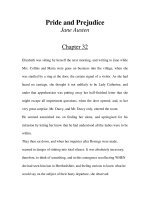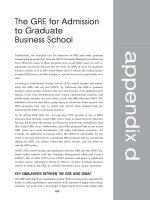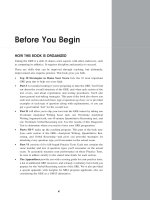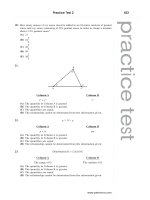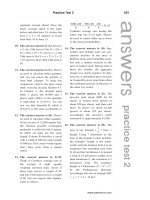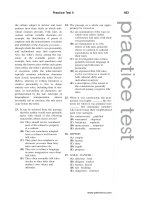Tài liệu Importing the Law in Post-Communist Transitions The Hungarian Constitutional Court and the Right to Human Dignity pptx
Bạn đang xem bản rút gọn của tài liệu. Xem và tải ngay bản đầy đủ của tài liệu tại đây (673.19 KB, 238 trang )
IMPORTING THE LAW IN POST-COMMUNIST TRANSITIONS
This book, one of the very first monographs on the Hungarian Constitutional
Court available in English, is a unique study of the birth of a new legal system
after the collapse of communism in Central and Eastern Europe. It shows that
the genesis of the new legal order was determined by massive Western involve-
ment and an unprecedented level of exportation and importation of law.
Anchored in a detailed comparative study of German and Hungarian constitu-
tional case law on human dignity, this book argues that law importation was a
deliberate strategy carried out by the Hungarian Court in the early years of its
operation. It explains how the circumstances of the transition and the back-
ground of the importers determined the choice of German case law as a model
and how the Court used it to construct its own version of the right to human dig-
nity. It highlights the Hungarian Court’s instrumentalisation of imported law in
order to lay the foundations of a new conception of fundamental rights. While
focusing on the Hungarian experience, this book engages with international
debates and provides an original theoretical framework for approaching the
movement of law from the importers’ perspective.
Volume 1 in the series, Human Rights Law in Perspective
Human Rights Law in Perspective
General Editor: Colin Harvey
The language of human rights figures prominently in legal and political debates
at the national, regional and international levels. In the UK the Human Rights
Act 1998 has generated considerable interest in the law of human rights. It will
continue to provoke much debate in the legal community and the search for
original insights and new materials will intensify.
The aim of this series is to provide a forum for scholarly reflection on all
aspects of the law of human rights. The series will encourage work which
engages with the theoretical, comparative and international dimensions of
human rights law. The primary aim is to publish over time books which offer
an insight into human rights law in its contextual setting. The objective is to
promote an understanding of the nature and impact of human rights law. The
series is inclusive, in the sense that all perspectives in legal scholarship are wel-
come. It will incorporate the work of new and established scholars.
Human Rights Law in Perspective is not confined to consideration of the UK.
It will strive to reflect comparative, regional and international perspectives.
Work which focuses on human rights law in other states will therefore be
included in this series. The intention is to offer an inclusive intellectual home for
significant scholarly contributions to human rights law.
Volume 1 Importing the Law in Post-Communist Transitions
Catherine Dupré
Importing the Law in
Post-Communist Transitions
The Hungarian Constitutional Court
and the Right to Human Dignity
CATHERINE DUPRÉ
OXFORD – PORTLAND OREGON
2003
Hart Publishing
Oxford and Portland, Oregon
Published in North America (US and Canada) by
Hart Publishing c/o
International Specialized Book Services
5804 NE Hassalo Street
Portland, Oregon
97213-3644
USA
© Catherine Dupré 2003
The Author has asserted her right under the Copyright, Designs and Patents
Act 1988, to be identified as the author of this work
Hart Publishing is a specialist legal publisher based in Oxford, England.
To order further copies of this book or to request a list of other
publications please write to:
Hart Publishing, Salter’s Boatyard, Folly Bridge,
Abingdon Road, Oxford OX1 4LB
Telephone: +44 (0)1865 245533 or Fax: +44 (0)1865 794882
e-mail:
WEBSITE: http//www.hartpub.co.uk
British Library Cataloguing in Publication Data
Data Available
ISBN 1–84113–131–8 (hardback)
Typeset by Hope Services (Abingdon) Ltd.
Printed and bound in Great Britain on acid-free paper by
Biddles Ltd, www.biddles.co.uk
This book is dedicated to
my grandparents
This is the first book in the series Human Rights Law in Perspective. I am
pleased to be able to launch the series with this comprehensive study. As Dr
Dupré notes, there is much interest in the work of the Hungarian Constitutional
Court. This monograph is a welcome and significant addition to the existing
literature. Although the focus is on the Constitutional Court, Dr Dupré also
maps the birth of a new legal order in Hungary and the theoretical framework
she develops for explaining law importation will be of general interest.
The book addresses the development of the right to human dignity and the
way that law importation was used to construct a new foundation for funda-
mental rights in Hungary. As Dr Dupré argues, the Hungarian Constitutional
Court was a prolific importer of foreign law in the early stages of the transition.
But the process of law importation in Central and Eastern Europe went far
beyond the courts, as she notes. By ‘law’ she means rules, principles, standards
of constitutionality, institutions or methods of adjudication. The German
model, in particular, was employed extensively in the process of overcoming the
past.
Law importation is placed at the centre of the transition in Hungary. Hard
questions are asked in this book. Dr Dupré focuses on the perspective of the
importer in an attempt to understand the legal and non-legal reasons for the
process. Who were the exporters and importers? What models were most exten-
sively used and why? How was the Hungarian Constitutional Court able to
import foreign law in the way it did? These are all questions thoroughly exam-
ined in this book. Dr Dupré argues that although the Constitutional Court used
the language of globalisation or ius commune the law it imported was more
specific. Faith was placed in the new language of law and the Constitutional
Court proved to be a persuasive institutional actor in Hungary. The idea of a
judicial dialogue played some part in this, but it appears that the Court also had
to speak the right language and this largely meant opening a legal path to the
West. She maps the adoption of foreign law as a modern substitute for natural
law in the transition and highlights the fact that the Constitutional Court was in
a strong position to introduce liberal values into the constitutional system. This
is traced to an argument about a European, and even global, legal enterprise. Dr
Dupré is sceptical about rhetorical claims surrounding the globalisation of
rights. For example, two points she makes stand out. First, that the globalisa-
tion of rights in the post-communist transitions was a one-way process with
little attempt in the West to learn from the protection of social rights. Secondly,
her phrase ‘not global but German’ highlights the particular nature of law
importation in Hungary. Although the judges talked of global law, they had a
specific example in mind which could solve the problems they faced in constitu-
tional adjudication. As this book explains, the strategy worked, in the narrow
sense that the Court was able to construct the foundations of a new constitu-
tional order underpinned by liberal values. In the longer term Dr Dupré is less
certain about this approach.
The transitions in Central and Eastern Europe must be viewed in their specific
contexts. However, they continue to attract detailed scrutiny and some lessons
may be learned. While Dr Dupré focuses on Hungary, questions are raised and
answers provided which are of general relevance. This impressive work is a
significant contribution to the debate and it is a pleasure to be able to include it
in this series.
Colin Harvey
December 2002
viii Preface
Summary Contents
Acknowledgements xv
List of Tables xvii
Table of Cases xix
Introduction 1
PART I. IMPORTING WESTERN LAW
1. New Constitutions After Communism 15
2. The Importation of Law 39
PART II. THE STRATEGY OF IMPORTATION:
THE RIGHT TO HUMAN DIGNITY IN HUNGARIAN
CASE LAW, 1990–98
3. Importing Human Dignity from German Law 65
4. Choosing the Right Model 87
5. Instrumentalising the Model 105
6. Overcoming the Communist Legacy 129
PART III. THE GENESIS OF A NEW LEGAL SYSTEM
7. Imported Law: Between Natural Law and Globalisation 157
8. Conclusion 177
Select Bibliography 193
Index 211
Acknowledgements xv
List of Tables xvii
Table of Cases xix
Introduction 1
1. The Study of Transitions: a Disciplinary Crossroads 3
2. A Case Study: the Hungarian Constitutional Court 5
3. Inventing a Method 7
4. Law Importation 10
4.1. Context 10
4.2. Strategy 11
4.3. The Genesis of a New Legal System 11
PartI.IMPORTING WESTERN LAW 13
1. New Constitutions After Communism 15
1. From Communism to Liberal Democracies: Ideological Transitions 16
1.1. A Great Transformation . . . 16
1.2. . . . Taken in Giant Steps 18
2. New Constitutions under the Rule of Law 19
2.1. The Rule of Law as a Founding Principle 20
2.2. Separation of Powers 22
2.3. Individualism 23
2.4. Constitutional Courts 26
3. Hungary 28
3.1. A Gradual Transformation 28
3.2. A Revolution under the Rule of Law 29
3.3. The Amended Constitution: an Interim Compromise 31
3.4. A Powerful Constitutional Court 34
(a) Constitutional Judges 35
(b) Competences of the Court 35
4. Conclusion 37
2. The Importation of Law 39
1. Movement of Law Beyond National Borders 39
1.1. ‘Legal Transplants’ 40
1.2. ‘Transjudicial Communication’ 43
2. Exporting Western Law 46
2.1. An Inflation of Metaphors 47
2.2. Many Channels of Exportation 49
(a) International Institutions and Non-Governmental
Organisations 49
(b) International Experts 50
(c) Mixed Motives 51
3. Defining Law Importation 53
3.1. Who Imports Foreign Law? 55
3.2. Why Import Western Law? 55
(a) The Failure of Communist Law 56
(b) ‘Institutional Optimism’ 58
3.3. Measuring the Success of Law Importation 60
4. Conclusion 62
Part II. THE STRATEGY OF IMPORTATION: THE RIGHT
TO HUMAN DIGNITY IN HUNGARIAN CASE LAW,
1990–98 63
3. Importing Human Dignity from German Law 65
1. Importing a General Definition: Case 8/1990 66
2. Importing the Various Components of the Right to Human Dignity 68
2.1. The Right to Life and Human Dignity 70
2.2. Human Dignity and the General Personality Right 75
(a) The Right to Free Fulfilment of the Personality 79
(b) The General Freedom of Action 79
(c) The Right to a Private Sphere 81
(d) The Right to Self-Determination 82
3. Conclusion 86
4. Choosing the Right Model 87
1. Prestige 88
1.1. Modern Constitutions 89
1.2. Western Constitutions 92
2. Knowledge 95
2.1. A Matter of Language 96
2.2. Personal Connections: the Availability of Knowledge 99
3. Suitability 101
4. Conclusion 104
5. Instrumentalising the Model 105
1. Importing is not Imitating 106
1.1. Minimal Adjustments 106
(a) The Nature of Human Dignity: a Principle and a Right 107
xii Contents
Contents xiii
(b) The Link Between Human Dignity and the General
Personality Right 109
(c) Human Dignity for Legal Persons? 112
1.2. Significant Differences 113
(a) Dignity Before Birth 114
(b) Dignity After Death 117
2. Instrumentalising the Model: an Isolated Individual 120
2.1. Importing Rights Without the Corresponding
Restrictions 120
2.2. Individualistic Humanity 122
(a) Focusing on Autonomy and Self-Determination 122
(b) Individuals Fighting Against the State 125
3. Conclusion 126
6. Overcoming the Communist Legacy 129
1. Rights Inherited from Communism 129
2. Human Dignity as a Rupture with Communist Law 134
2.1. Setting Aside the Rights Inherited from Communism 134
2.2. Nullifying Communist Rules 140
(a) Freedom of Association 143
(b) Public Prosecutors 144
(c) Social Rights 146
3. Introducing a New Concept of Rights 147
3.1. Reversing the Communist Understanding of Rights 147
3.2. Inherent Individual Rights 148
3.3. Statutory Requirement 150
3.4. Judicial Protection Against the State and Public Bodies 151
4. Conclusion 153
Part III. THE GENESIS OF A NEW LEGAL SYSTEM 155
7. Imported Law: Between Natural Law and Globalisation 157
1. Imported Law as a Modern Substitute for Natural Law 157
1.1. By-Passing the Taboo of Ideology 158
1.2. An Alternative Set of Values . . . 161
1.3. . . . Exterior to the Work of the Court 162
2. Imported Law: an Example of Globalisation at Work? 163
2.1. The Rhetoric of Global Law 163
(a) Universality 163
(b) The Argument of Global Law 165
(c) Taking Part in the Global Development of Law 167
2.2. Global Law or Selected Law? 168
(a) Some Rights are More Global than Others 169
(b) Not Global but German 171
3. From Prestige to Binding Force: Learning the Law 171
3.1. The Neo-Colonialism Hypothesis 172
3.2. The Failure of the Hungarian Constitution? 173
3.3. Learning the Law 174
4. Conclusion 176
8. Conclusion 177
1. Does Law Importation Work? 177
1.1. The Short Answer: Yes 177
1.2. The Long Answer: Caution and Vulnerability 178
(a) Waning Enthusiasm for the West 179
(b) Speaking the New Language of Law 181
(c) Beyond Elite Importers: Sharing the Knowledge 184
2. Faith in Law and the Might of Words 187
3. The Importance of Personalities 188
4. No Big Bang in the Creation of a New Legal System 190
4.1. Importation versus Innovation 190
4.2. Going Towards the Future Without a Past? 191
Select Bibliography 193
Index 211
xiv Contents
Acknowledgements
This research was conducted over a period of 10 years during which time I lived
in five different countries and learnt three languages. The project started
germinating when I was still an undergraduate student and first encountered
comparative constitutional law at the Max Planck Institute in Heidelberg. It
subsequently became the subject of my Diplôme d’Études Approfondies (DEA,
equivalent to a LLM) dissertation and of the PhD proposal that I submitted to
the European University Institute (EUI), where I undertook most of the research
on which this work is based.
As this was such a new field, I have often felt the isolation of long term
research as I was venturing into constitutional adjudication in post-communist
countries. On the completion of this book I realise, however, that I have bene-
fited from the support of several people without whom this monograph would
never have been completed and I wish to thank them here in a roughly chrono-
logical order.
I am grateful to the French Ministry of Culture and Education for the finan-
cial support (bourse Lavoisier) that I received at the EUI for two years of my
doctoral research. The EUI was probably the only place where I could have car-
ried out such an extravagant project at the time in such a delightful environ-
ment. I am particularly grateful to Professor Philippe Schmitter for sitting on my
PhD panel, as well as for his support at the very end of my thesis which gave me
strength to go on with this project.
This book would not have been possible without the Max Planck Institute in
Heidelberg, where I was always welcome to use its fantastic library. In particular,
I am grateful to Christoph Benedict for reading my PhD dissertation and
commenting on my analysis of German case law. I am also grateful to Lutger
Radermacher for reading and commenting on some of the draft chapters of this
book and for his very kind suggestions for improving some of the footnotes.
I wish to address sincere thanks to the Hungarian Constitutional Court and
its members, constitutional judges and their advisors, whose openness provided
me with invaluable insight into this exceptional period of foundation. The pres-
ident of the Court, László Sólyom, always managed to find time to discuss issues
with me, as did his colleagues Justices Antal A
´
dám, Tamás Lábady, Imre Vörös
and János Zlinsky. I also found a lot of friendly support in the triumvirate of the
first advisors to the president: Péter Paczolay, Gábor Halmai and Botond
Biskey. The librarian of the Court, Ms Judit Petróczi, helped me find my way
around Hungarian literature and materials.
I wish to thank Professor Georg Brunner (Institut für Ostrecht, Cologne
University) for his encouragement and very friendly assistance with understanding
Hungarian case law. During my time at the University of Birmingham, I received
invaluable support and encouragement from Professor David Feldman. I am also
particularly grateful to Professor Istvan Pogany (University of Warwick) for his
friendly support with this huge enterprise and for his perceptive and helpful
comments on draft versions of some chapters. Last but not least, I was very glad
that Richard Hart accepted my proposal and I have greatly appreciated his patient
support while I was writing this book.
This work has involved much linguistic effort, including learning Hungarian
and translating human dignity cases. I wish to thank particularly warmly Judit
Nagy-Darvas, my remarkable Hungarian teacher, who happened to be in
Florence for one year when I started this research in 1994.
I am also very grateful to three Hungarian lawyers who were fellow research
students at the EUI between 1995 and 1998. Péter Munkacsi very kindly sent me
the first Hungarian cases available in English and helped me to find resources in
the Library of Parliament in Budapest. Orso´lya Farkas and János Volkai con-
tributed with great patience and kindness to this work and made sure that my
translations and interpretations did not deviate from the original Hungarian of
the constitutional cases.
This book, however, would not have materialised without the support and
assistance of Dr Stephen Skinner (University of Warwick). This study has gen-
erated many thousands of words, but I still lack the right ones to express my
gratitude to him.
xvi Acknowledgements
List of Tables
1. Human Dignity—a multi-faceted right 69
2. The importation of human dignity from German constitutional
case law—synopsis 76
3. The communist legacy 130
4. Setting aside rights inherited from the communist constitution 136
5. Breaking with the communist past 141
Case 8/1990 on trade unions (23 April) 65, 66-67, 68, 69, 71, 77, 82,
85, 110, 112, 123, 134,136, 137, 141, 143, 145, 146, 152, 161, 188
Case 9/1990 on taxation and discrimination (25 April) 91–92
Case 23/1990 on the death penalty (31 October) 69, 71, 72, 76, 80,
108, 114, 124,136,139, 141, 147–48, 162, 164
Case 27/1990 on sport associations (22 November) 69, 77, 79,
80, 136, 141, 143
Case 7/1991 on membership of cooperatives and restrictions
to fundamental rights (28 February) 112
Case 15/1991 on the personal identification number
(13 April) 69, 77, 90, 92–94, 136, 141, 162
Case 16/1991 on the preventive review of norms (20 April) 36, 92, 94
Case 46/1991 on good reputation and enforced payment
of a debt (10 September) 77, 81, 136, 139, 141
Case 57/1991 on the right to self-identification, i.e. to
ascertain one’s biological origins (8 November) 69, 76, 78, 82–83, 85,
111, 136, 137–38, 141, 146, 149, 161
Case 64/1991 on abortion (I) (17 December) 65, 71–72, 74, 76,
77, 80, 82, 110, 111, 116, 119, 136, 139, 141, 150–51
Case 9/1992 on public prosecutors’ powers and the
‘protest of illegality’ (30 January) 69, 76, 78, 85, 111,
136, 139, 141, 144, 145
Case 11/1992 on the prosecution of serious crimes committed
between 1944 and 1990 (5 March) 140
Case 22/1992 on the freedom of marriage for firemen
and the military (10 April) 69, 76, 136, 138, 141
Case 4/1993 on freedom of religion and restitution of
Church property (12 February) 69, 78, 110–11, 136, 140, 141, 143
Case 23/1993 on freedom of marriage for policemen
(15 April) 69, 76, 136, 138, 141, 143
Case 1/1994 on public prosecutors’ power to intervene in
civil proceedings (7 January) 69, 76, 78, 80, 85, 111, 136, 139, 141, 144
Case 28/1994 on the right to a healthy environment
(20 May) 69, 73–74, 90, 112, 136, 142, 143, 146
Case 36/1994 on freedom of expression and the right to
criticise official persons (24 June) 69, 77, 82, 136, 142
Case 56/1994 on civil servants’ private sphere
(10 November) 70, 77, 82, 136, 142
Case 35/1995 on access to higher education (2 June) 70, 77, 79, 136,
138-39, 142, 146, 149
Case 43/1995 on maternity and child care
benefits and allowances (30 June) 70, 74, 137, 140, 142, 143, 146
Case 75/1995 on paternity proceedings, i.e. prosecutors’ power
and the right to self-identification (21 December) 70, 76, 78, 85,
111, 137, 139, 142, 146
Case 12/1996 on access to higher education (22 March) 70, 77, 79, 137,
138, 142, 146, 149, 151
Case 22/1996 on compensation for deprivation of death
and liberty on ideological grounds (25 April) 118–19
Case 24/1996 on cultural associations and works of art
(25 June) 70, 78, 80, 112-13, 137, 142, 143, 144
Case 20/1997 on public prosecutors’ powers and freedom
of information (19 March) 70, 78, 85, 137, 139, 140, 142
Case 48/1998 on abortion (II) (23 November) 73, 76, 77, 116
xx Table of Cases
Introduction
A
T THE END of the summer of 1989, the first wave of ‘tourists’ from Eastern
Europe travelled to the West. In autumn 1989, the collapse of the Berlin
Wall marked the end of almost half a century of communist dictatorships and
inaugurated a new era. A period of intensive changes started to reshape the
political and institutional architecture of Europe. The dismantling of the Soviet
Union provoked the emergence of new independent states and the disappear-
ance of others, after reunification or secession. Everywhere, in response to these
changes, new constitutions were enacted or old constitutions were substantially
amended.
Central and Eastern Europe, the study of which had waned and was essen-
tially left to sovietologists and other specialised research centres, attracted fresh
interest and, indeed, this caused a welcome excitement in the academic
community. The scale of the changes affecting virtually all academic disciplines
opened dazzling research perspectives—in particular for comparative lawyers.
All disciplines were challenged to propose an explanation for this incredible and
unforeseen phenomenon, leading to developments in the areas of, for example,
élite studies, institutional studies, micro/macro economics, political and legal
theory. Every school of thought endeavoured to tackle the end of what had been
the main division of the world for the previous 50 years, an ideological divide
under which a generation was born, that it had always known and accepted as
an ineluctable feature of the world.
1
The lives of the older generation, those who
had known the world before the emergence and the development of two oppos-
ing blocs, had also been transformed and shaped by the division. The shock
caused by the unexpected and complete demise of the Soviet empire was such
that one of the first academic interpretations of this phenomenon was to call it
‘the end of History.’ However, the world recovered from this great transforma-
tion and new states, institutions, international structures and life in general
went on, as indeed did History.
The collapse of communism was fascinating because it radically transformed
the world and Europe in particular. Yet for such a massive change, it took place
in a relatively peaceful way. This was particularly true of the years 1989–90 and
of the way the process of change was initiated. Of course, we cannot forget the
1
J Elster, C Offe and UK Preuß start their book on Institutional Design in Post-communist
Societies: Rebuilding the Ship at Sea by pointing out that: ‘The breakdown of the European regimes
of state socialism and the subsequent efforts to establish a new social order in its former domain are
arguably the most consequential, as well as most fascinating, historical events in the authors’ adult
lifetime’ (Cambridge, Cambridge University Press, 1998), 1.
dismantlement of Yugoslavia and the extreme violence of the Balkan wars, the
military repression of Tchechen rebels, nor the fact that in Romania the change
of regime culminated in the execution of the Ceausescus and that very violent
strikes and demonstrations were among the main features of the Romanian
transition. On the whole, however, the generally peaceful and controlled char-
acter of the shift from communism may be appreciated in relation to the unful-
filled fears of a third world war and nuclear Armageddon that the Cold War had
(maybe not without reason) entertained. Perhaps we Westerners were relieved
to observe that the changes in Central and Eastern Europe did not affect the
comfort of our daily lives. In contrast with what had happened in previous
democratic transitions in Southern Europe, as well as in South America, the
military did not play a major role, nor did it represent a major threat. The
post-communist revolutions were, as it seemed at first, initiated and conducted
by the people themselves. Dissidents played a leading role in this process,
together with civil society, maybe particularly in countries like Poland, East
Germany and Hungary. In fact the post-communist revolutions seemed to fit
into a sort of ideal representation of revolution where the people pooled their
efforts and resources to throw out ‘bad’ communist dictators in order to replace
them with democratically elected leaders.
After the first and most spectacular changes, the realisation began to dawn
that perhaps these revolutions were far more complex than they first appeared,
and since then it has become increasingly difficult to define them in general
terms, or even to define them under the sole term of ‘revolution.’ Indeed, one of
the difficulties of understanding the changes is reflected in the lack of one satis-
factory term to label them.
2
The people involved in these changes often pre-
ferred not to use the word ‘revolution’ to refer to the events of the 1990s. In
countries such as Czechoslovakia and Hungary, this term was very soon quali-
fied, as in ‘velvet revolution’ or in ‘refolution,’ in an attempt to represent the
idea of the gradual and perhaps moderate character of the changes, in contrast
to the usual sense of ‘revolution,’ which historically has been associated with
extreme violence and brutality, as in the French or Bolshevik revolutions.
3
In
Hungary, the years 1989–90 are more commonly referred to as ‘rendszerváltás’
(‘change of system’), which translates well into German as ‘Systemwechsel.’
Rudolf Tökés captured the particular nature of the Hungarian changes with the
phrase ‘negotiated revolution’ which is also the title of his book.
4
The term ‘transition’ is perhaps the lowest common denominator, but
although it indicates a gradual move from one set of circumstances to another,
it remains non-specific and it does not fully indicate the particular character of
2 Importing the Law in Post-Communist Transitions
2
See the reflections of J-Y Potel on this, Les Cent Portes de l’Europe Centrale et Orientale (Paris,
Les Editions de l’Atelier, 1998), 45–46.
3
TG Ash, We the People: The Revolution of 89 Witnessed in Warsaw, Budapest, Berlin and
Prague (London, Granta Books, 1990), 14.
4
R Tökés, Hungary’s Negotiated Revolution: Economic Reform, Social Changes and Political
Succession (Cambridge, Cambridge University Press, 1996).
the changes in Central and Eastern Europe. At first, this term was adequate
because the collapse of communism was seen to be a shift from the lack of
democracy to democracy. However, it soon became clear that it was not only
a matter of abandoning the so-called ‘peoples’ democracies,’ but also a matter
of economic transformation and fundamental ideological reconstruction. The
simple term ‘transition’ actually embraced all aspects of the definition of a
state: ideology, society, politics, economics and law. It is therefore an appar-
ently simple term that must be understood as encapsulating a wide range of
elements.
This book is concerned with the legal dimensions of the changes as they are
reflected in a new constitution and one of its essential post-communist features,
constitutional adjudication. This legal analysis is nevertheless undertaken in the
context of the wider aspects of ‘transition’ in Central and Eastern Europe. In the
absence of better terms and rather than trying to create a more accurate neolo-
gism to describe the collapse of communism and its consequences, I will use
both ‘transitions’ and ‘changes’ with no implied difference in meaning.
1. THE STUDY OF TRANSITIONS: A DISCIPLINARY CROSSROADS
Post-communist transitions have now given birth to a new kind of academic, the
‘transitologist’; but back in 1989, there was no particular discipline designed to
concentrate on these changes and the first commentators came from a wide
range of areas.
Some scholars came from Soviet studies, that is an area essentially concerned
with the Soviet Union in its political and economic dimensions, and secondarily
with other countries of the communist bloc. The sovietologists certainly suf-
fered from the inability of their discipline to predict the fall of the Iron Curtain
and they were momentarily discredited as a result. Even so, they had invaluable
knowledge of the Soviet Union. They were familiar with the social and cultural
situation there, they often had contacts and links with (post)-communist bodies,
they spoke Russian and, as a result, they could gain access relatively rapidly to
what was happening in the former Soviet bloc.
Another significant group of academics comprised the observers of democratic
transitions in other parts of the world, such as South America and Southern
Europe. With their experience and knowledge of post-totalitarian democracies,
they turned to post-communist systems, probably eager to test their hypotheses
and to extend their empirical field of studies.
5
Their main difference from
Introduction 3
5
See PhC Schmitter, G O’Donnell and L Whitehead (eds), Transitions from Authoritarian Rule:
Prospects for Democracy (Baltimore, Johns Hopkins University Press, 1986); JJ Linz and A Stepan,
Problems of Democratic Transition and Consolidation: Southern Europe, South America and
Post-Communist Europe (Baltimore, Johns Hopkins University Press, 1996) and A Przeworski,
Democracy and the Market, Political and Economic Reforms in Eastern Europe and Latin America
(Cambridge, Cambridge University Press, 1991).
the sovietologists was perhaps that, despite lacking specialist knowledge, they
possessed a conceptual frame through which they could understand (and assess)
what was happening. This allowed a clarification of the post-communist turmoil:
they identified the components of the transitions and the various steps of this
process.
Lawyers too were active contributors to the study and observation of post-
communist transitions. Their role was slightly different in that they were perhaps
more involved in the mechanics of transformation by providing advice, technical
expertise and assistance, crash courses in, for example, human rights, the rule of
law and the separation of powers. Back home, they often reported in law journals
(as well as to their colleagues and students), in a descriptive and informative man-
ner, on what they had seen in the East. However, in contrast to political science,
there does not yet seem to be a strong and clearly organised group of lawyers who
could be identified as specialising in post-communist legal developments. Those
lawyers who have shown an interest in this area have rather done so by extending
a pre-existing interest in a specific branch of law, such as constitutional law, com-
pany law or family law for example, to the post-communist context. Similarly,
post-communist law has now been integrated into the study of European (Union)
law as the enlargement issue and its related problems have come to include the
issue of the Union’s external borders and what lies beyond them.
On its own, none of the disciplines outlined above (or of the other disciplines
that I may have omitted here) can claim to possess ‘the truth’ about post-
communist transitions; nor can any discipline claim to understand fully and to
be able to explain (let alone to predict) the changes that are taking place. Each
discipline has developed a partial explanation which is often only valid for the
particular group of countries considered in a given study, such as the Visegrad
states, the Baltic states, the Balkan states (with a subdivision to include the ex-
Yugoslavia) or the Central European states. More recently, the summa divisio
in the approach to post-communist states has been between the states which can
join the European Union soon, and all the others.
These various groupings of states illustrate scholarly efforts to cope with the
immensity of the field, the sheer number of countries involved and the complex-
ity of related issues which make it impossible to claim genuine knowledge and
understanding of the whole phenomenon of post-communist transitions. Even the
categories themselves, mentioned above as examples, are questionable as to their
content and their extent: they will inevitably include a disturbing case which does
not fit with the rest of the category, but which nevertheless cannot be excluded. In
other words, despite apparent resemblances between countries in a group, it is
almost impossible to develop a meaningful explanation that applies to more than
one country. The more we know and the more the ‘post-communist transitions’
develop, the more it becomes difficult to have an overview and to restrict the field
of study to a neat set of countries or indeed to a single discipline.
4 Importing the Law in Post-Communist Transitions
2. A CASE STUDY: THE HUNGARIAN CONSTITUTIONAL COURT
If determined to go on with the study of post-communist transitions, we are
forced to restrict the scope of observation. The option of a case study thankfully
rescues us from this inextricable and frustrating situation; but the selection of
the case studied needs to be qualified. It would be an exaggeration to claim that
the choice of Hungary and the Hungarian Court at the outset of this study was
entirely guided by objective and theoretical criteria, as this would negate the role
of coincidences and chance in this undertaking. Having said that, Hungary was
a very suitable choice for a case study and Hungarian constitutional law is fas-
cinating in more than one way. Furthermore, Hungary probably embodied the
mildest form of communism in Central and Eastern Europe and the Kádár
regime with its ‘goulash communism’ had significantly relaxed the dogmas of
Moscow. Unlike some other communist countries, Hungary under communism
was not completely cut off from the West and it managed to maintain privileged
links with liberal democracies and with West Germany in particular. As a result,
one can consider that Hungary was more or better prepared for the change of
regime. In fact, some commentators date the beginnings of change back to 1956.
Challenges to the Kádár regime itself, which culminated in 1988 when he had to
leave the Politburo, stretched back to the 1970s. The famous samizdat move-
ment started in the 1980s and was crucial in stimulating political opposition.
When Kádár died in July 1989 aged 77, on the day of Imre Nagy’s rehabilitation
by the Hungarian Supreme Court, it was clear that this would open the way to
more fundamental changes. In September 1989, Hungary was the first commun-
ist country to open its border with the West in order to allow 12,000 East
German ‘tourists’ to cross over into Austria.
The relatively mild character of the communist regime in Hungary, together
with a relative openness to the West, were also noticeable at the legal level. In
1975, Hungary signed the Helsinki Agreement and modified the 1949
Constitution. In 1983, a further constitutional amendment created the Council
for Constitutional Law. Although it did not challenge the principle of unity of
powers, which was at the heart of the communist legal system and meant that
the law-maker was not subject to any controls, it was the first attempt to intro-
duce some review of the constitutionality of norms. Commentators noted that
this reform only enacted a mild version of the proposals which had been put
forward at the time by Hungarian academics, thus indicating that significant
constitutional reforms were already the subject of discussion in legal circles.
6
Introduction 5
6
Gy Antalffy, ‘Modification de la constitution en Hongrie’ [1984] Revue de Droit Hongrois
5–19; I Kovács, ‘Du droit public hongrois au droit constitutionnel socialiste hongrois’ [1987] Acta
Juridica Academiae Scientiarum Hungaricae 321–344; G Rácz, ‘Einführung der Verfassungs-
normenkontrolle in Ungarn’ [1984] Juristenzeitung, 879; A Takács, ‘Problems of the Protection of
the Constitution, with Special Regards to the Constitutional Law Council’ [1987] Acta Juridica
Academiae Scientiarum Hungaricae 165–92.



